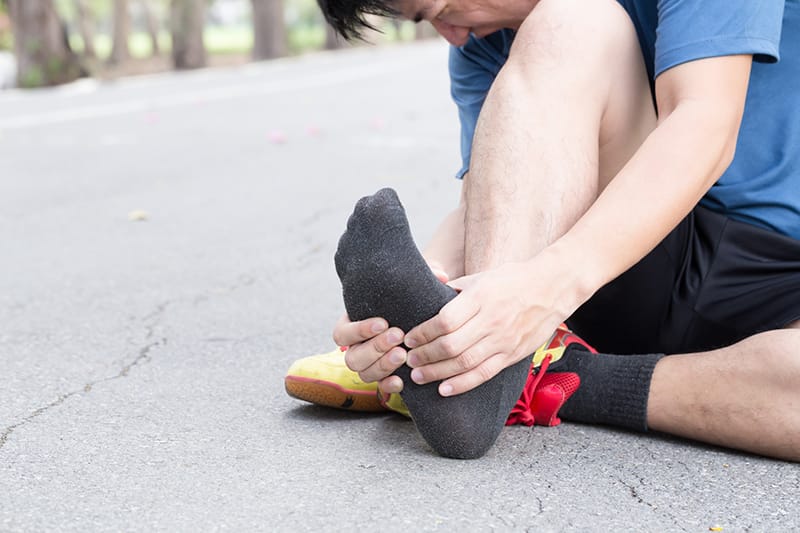Pain in your foot or heel can sideline you from physical activity, even everyday activities. Physical therapy and simple home remedies can get to the root of your pain.
Posted
by Featured Provider Jill Berg on Thursday, June 27, 2019
 Your feet and ankles carry a heavy burden — your entire body weight! With every step you take, they endure a large amount of force. As you get older and when you get injured, the ligaments and tissues in the foot can change, altering the forces on your feet and ankles and causing you pain.
Your feet and ankles carry a heavy burden — your entire body weight! With every step you take, they endure a large amount of force. As you get older and when you get injured, the ligaments and tissues in the foot can change, altering the forces on your feet and ankles and causing you pain.
There are many reasons your feet may hurt. It could be the residual effects of an old injury. Maybe it's just poor-fitting shoes. Foot pain decreases your stability, mobility and strength. It can alter how you walk, stand, run or jump and affect the functioning of your knees, hips and back. This can be very debilitating since you use your feet and ankles to perform most daily activities.
Plantar fasciitis is one of the most common sources of foot pain. With the right treatment, you can get rid of the pain and get back on your feet.
What is plantar fasciitis?
Plantar fasciitis is a condition that causes heel pain that radiates into the bottom of your foot. It can happen to anyone, at any age, but it's an overuse injury that is more common in runners and people who are on their feet more often.
The plantar fascia is a thick band of tissue that connects your heel to the ball of your foot and supports the arch. Poor foot positioning can cause the structures in your foot to load incorrectly, which puts pressure on the band. An injury to the tendons in your foot and ankle can also damage the fascia.
When the plantar fascia becomes inflamed, irritated or weak, it can tear and cause a stabbing sensation in your heel and other pain symptoms:
- Increased pain in the morning or when taking the first few steps after resting.
- Increased heel pain with prolonged standing, walking and stair climbing.
- Increased pain when standing and walking on hard surfaces or without proper shoe support.
Sometimes, as your body warms up, plantar fasciitis pain decreases — only to worsen once your activity progresses.
What's the best treatment for plantar fasciitis?
Plantar fasciitis can last for months. The pain can make exercise impossible and normal daily activities unbearable. There are many other causes of heel pain so you should consult your doctor or physical therapist for proper diagnosis. If plantar fasciitis is the cause of your heel peel, a treatment plan can help speed up your recovery.
Physical Therapy
Physical therapy will help you return to your desired activities by improving the way your foot is loaded, restoring mobility to your tissue and addressing areas of weakness or imbalances in your foot. There are several effective physical therapy treatments, including
- Manual therapy – Physical therapists use their hands and/or ASTYM®/Graston tools® to manipulate the soft tissue in your foot. It's like a massage for the plantar fascia. Manual therapy loosens the tight tissue and reduces inflammation.
- Dry needling – A common treatment for a variety of overuse injuries, dry needling targets trigger points that cause pain. Placing tiny needles into the fascia causes it to release and the pain fades away.
- Night splints – Wearing a splint while you sleep keeps your foot in a better position throughout the night. So when you wake up, you won't feel the stabbing pain in your first few steps out of bed.
- Taping – Kinesiology tape, or KT tape, works similar to a night splint. A physical therapist tapes your foot in a position that better supports your foot's natural arch and takes pressure off the fascia.
- Iontophoresis – Physical therapists can also use iontophoresis, which uses electrical stimulation to send topical pain relievers deeper into the soft tissue.
Supportive Shoes
The right shoe can make a big difference for your foot pain. The best shoes for plantar fasciitis have good arch support, cushioning, shock absorption and a thick heel. If you're an active runner or on your feet often, replace your shoes every 500 miles or when the back cushion of the shoe gets more than 2 creases. Doing so, will allow them to continue to provide the support you need.
Exercises and Stretches
You can wait for the fascia to heal on its own. Or you can work to strengthen it and make it more flexible and recover faster. Plantar fasciitis stretches and exercise help relieve heel pain, improve muscle strength and increase the flexibility in all the muscles, tissues and ligaments in your foot.
Perform these exercises and stretches two to three times a day to promote healing:
Calf Stretch
Lightly rest your hands on a wall or counter for support and stand with one foot forward and one foot back. Bend your front knee and lunge forward from your hips, keeping your back upright. Keep your back leg pointed straight forward and your knee straight and press your heel down on the floor. Hold this position for 30 seconds and repeat three times on each side.
Heel Raises
Stand at the wall or counter for support and raise onto your toes, then lower your heels back to the ground slowly. Go up and down until your feet are fatigued. Perform two or three sets. As you build strength, you can progress to standing on one foot and then to standing on one foot with your heels hanging off the edge of a step so that they can drop lower.
Rolling Pin
Sit in a chair with your feet on the floor. Loosen the plantar fascia by rolling the bottom of your foot along a frozen water bottle or rolling pin. Do this for two to three minutes.
Toe Stretch
Sit in a chair and cross your bad foot over the opposite knee. Pull back on your toes to stretch the bottom of your foot. Hold it for 10 seconds while massaging the bottom of your foot. Repeat three times.
Towel Curl
Sit in a chair and place a towel on the floor under your painful foot. Curl your toes toward your body and work to scrunch up the towel. Repeat 10 times.
It can take up to a year for your fascia to fully recover and your foot pain to fade away. But with a daily routine of plantar fasciitis stretches, supportive shoes and other treatments, you can heal much faster. Get the help of a physical therapist or check out the Bone & Joint Center to find which treatments are a fit for your feet.
Meet This Featured Provider

Learn More About:
Physical Therapy
Jill Berg, PT has been with The Iowa Clinic since 2012. The Iowa Clinic offers her the flexibility to be active in her children's lives and allows her to grow as a professional with the advancements of medical care and technology. The different specialties at The Iowa Clinic allow for a ... Read More
Accepting New Patients
Schedule Now
Other Physical Therapy
Tags
- bone and joint center
- physical therapy